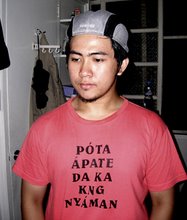My thesis proposal during my stay in the Broadcast Communication Department of the UP
But that topic was a trimmed down version of what I originally would like to make a study of. I wanted to cover all forms of mass media: print, film, radio, and even theater.
 In the area of film, I would personally call Brillante Mendoza the father of Kapampangan films. While there is no evident Kapampangan film industry yet, ever since his series of films, young Kapampangan filmmakers have been inspired to write screenplays using their Ámanung Sisuan.
In the area of film, I would personally call Brillante Mendoza the father of Kapampangan films. While there is no evident Kapampangan film industry yet, ever since his series of films, young Kapampangan filmmakers have been inspired to write screenplays using their Ámanung Sisuan.
(L-R: Film distributor Ferdie Lapuz, Director Brillante Mendoza, and Coco Martin)
Although not entirely Kapampangan when it comes to the language used, they offer a great deal of Kapampangan stuff, like festivals, traditions, superstitions, and comic relief only Kapampangans (by land of birth and language spoken) would be able to relate and give significance to.
Before I make a review of his three films, Masahista, Mánoro (The Aeta Teacher), and Káleldo (Summer Heat), you might want to read this Manila Standard Today article featuring him, to know more about this cultural entrepreneur.
Masahista
 Center Stage Productions. Starring
Center Stage Productions. Starring
It’s not entirely a Kapampangan film, because the story takes place both in
 The opening scene of the movie was enough to make me relate it to my life as a Kapampangan studying in Quezon City going home every now and then to Pampanga: the view of the plains and rice fields along the North Luzon Expressway under the vast firmament.
The opening scene of the movie was enough to make me relate it to my life as a Kapampangan studying in Quezon City going home every now and then to Pampanga: the view of the plains and rice fields along the North Luzon Expressway under the vast firmament.
Then we are taken to sites and objects such as the kalésa (horse-driven carriage), pedicabs (public transport tricycles that house no motors), and the parul (giant lantern)—all of which would be more familiar to a San Fernandino.
I live in

 There is really no beginning-climax-end to look out for in Masahista. As you might have read in the Manila Standard Today feature, critics say the story is flat; I couldn’t agree more. However, such sincerity is what makes me like most of Brillante Mendoza’s films. They are the show-don’t-tell type. Plus the culture and realistic happenings foster a sense of reality and sophistication.
There is really no beginning-climax-end to look out for in Masahista. As you might have read in the Manila Standard Today feature, critics say the story is flat; I couldn’t agree more. However, such sincerity is what makes me like most of Brillante Mendoza’s films. They are the show-don’t-tell type. Plus the culture and realistic happenings foster a sense of reality and sophistication.
Speaking of a sense of reality, on the bad side, it is obvious that the lead actors who have a number of Kapampangan lines are not Kapampangan, and the fact that they are not reeks in the way they deliver their Kapampangan lines.
 Coco Martin is obvious in trying to adopt the sort of singsong accent of Kapampangan. Foreign and non-Kapampangan viewers have the slightest probability to detect such flaw, but for a Kapampangan like me, I can only cringe or laugh at the mispronunciations the actors make.
Coco Martin is obvious in trying to adopt the sort of singsong accent of Kapampangan. Foreign and non-Kapampangan viewers have the slightest probability to detect such flaw, but for a Kapampangan like me, I can only cringe or laugh at the mispronunciations the actors make.
Try to listen to this verbal joust between Iliac and his younger brother Maldon, played by Aaron Christian Rivera, who’s genuine.
Worse, in some lines,
A native would find the line funny, because it should have been “Sóri pû, mé-lowbatt ku nabéngi.” Kapampangan verb tenses don’t sport the use of na- and the word ako is basically Tagalog.
 Jaclyn Jose was good. Almost. In some scenes, I was convinced that she indeed spoke the language.
Jaclyn Jose was good. Almost. In some scenes, I was convinced that she indeed spoke the language.
A magazine I read recently said she has Kapampangan blood, but I doubt she knows very well how to speak it. I can still sense the artificiality of the way she talks in Kapampangan as Natty, the tocino-making mother of Iliac in the story.
All of the extras in the Pampanga scenes, plus the siblings of Iliac and one or two of the masseurs, are genuine Kapampangans. I can tell by the way they speak. Also, seeing their minor characters behave the way I perceive Kapampangans to behave in some occasions—such as the brutal gossiping behind people’s backs, silent criticizing upon another’s misfortune, and overreaction to actually-no-big-deal stimuli—makes the film closer to home.



 Then, of course, the wonderful giant lanterns only San Fernandino craftsmen can erect beautifully.
Then, of course, the wonderful giant lanterns only San Fernandino craftsmen can erect beautifully.
They are made for the annual Liglígan Parul (Giant Lantern Festival). The behind-the-scenes footages of the DVD show the technical side of the giant lantern and how the lights are controlled.
I’m not really sure if the director/writer is trying to say something about life being like the magnificence of the giant lanterns and how people marvel at their beauty, but you are free to associate Iliac’s life with them.
It’s a great, even though simple and plain, film. In fact, it has earned a spot in my ‘Favorite Movies’ section in my Friendster profile. What taints it is the broken Kapampangan of the lead actors.
I’d like to believe that film is audio-visual and it is its innate goal to give the audience a sense of reality, not make them pretend to believe.
With lingual distortions, reaching the goal is about 25% hindered. Sadly, even in
But then again, I understand. There aren’t many Kapampangan-speaking actors.
Even in my own digital short Kapampangan film, my lead actors spoke Kapampangan artificially despite my passionate attempts of teaching them proper enunciation. It was hard getting Kapampangan actors, so I had no choice.
I just hope that in the future, this language thing would be fixed in Mendoza’s (and every Kapampangan filmmaker’s) films. I believe we’re on our way there.









3 comments:
napanood ko na ang masahista.
at ang masasabi ko lang.
hay. puro sex.
i watched masahista when it was shown at the movie theaters. buti nga naabutan ko pa ang bilis kc nawala. i dont know how to speak kapampangan pero lumaki ako na puro kapampangan ang nasa paligid ko, kapampangan din ako eh (half). kaya napansin ko nga na mali2 ang intonation. yeah, the story was flat, but the shots were amazing.
-cj-
hi every person,
I identified kamaru.blogspot.com after previous months and I'm very excited much to commence participating. I are basically lurking for the last month but figured I would be joining and sign up.
I am from Spain so please forgave my speaking english[url=http://latestnewsci.info/forum].[/url][url=http://workedonrss.info/].[/url][url=http://puthehottesttopics.info/].[/url]
Post a Comment